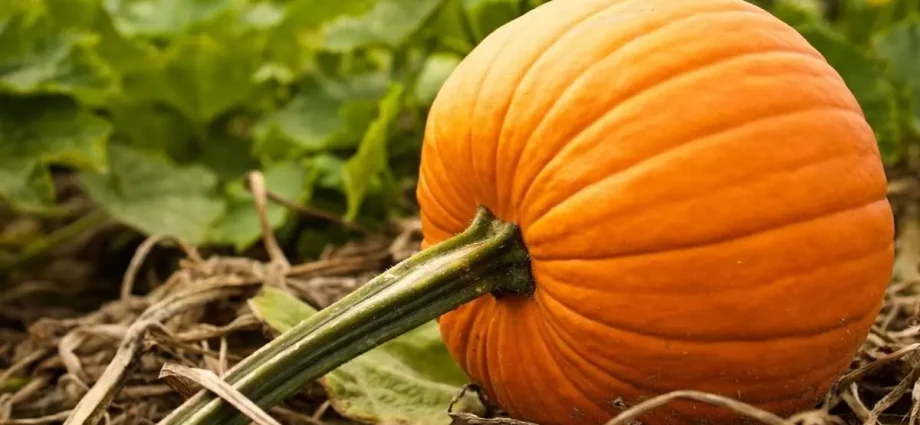Contents
Bush pumpkin is an unpretentious crop that is planted in all corners of Our Country. It gained popularity for its compact appearance, high and early harvest and unpretentious care. Thanks to the work of scientists, a large number of varieties have been developed that differ in size, color, taste and cold resistance. By choosing the right variety and observing simple agrotechnical rules, you can get a good and early harvest.
General description of the bush gourd
The bush gourd is a small, compact plant that is suitable for small home gardens. The stems of the culture are erect, there are no lashes, pumpkins are formed at the very base. The size, color and shape depend on the variety, but they have one similarity – early fruiting. After planting the seeds and before harvesting, no more than 3,5 months pass. There are no late-ripening varieties of bush pumpkin, so it does not have time to ripen in regions with an unstable climate.
When choosing the best variety of bush gourd, weather conditions, soil quality and growing characteristics must be taken into account.
For Siberia, such varieties of bush pumpkin are suitable as:
- Freckle – spherical-flattened fruits weighing up to 3 kg, ripen on the 90th day after the appearance of sprouts. Pumpkins are painted in emerald color with numerous yellow spots. The pulp is juicy, fragrant, sweet with a fruity aftertaste.
- Adagio – flattened fruits weighing up to 3 kg ripen 3 months after planting the seeds. The pulp is sugary, juicy and aromatic. Adagio refers to a dietary product, so it is used in the children’s menu.
Popular cold-resistant varieties of bush pumpkin for the Urals:
- Country house – an early ripe plant with fruits weighing up to 4 kg. Green with yellow stripes pumpkins have a good taste and aroma. Productivity and keeping quality are good, the crop is suitable for the preparation of baby food.
- Gold – rounded flattened vegetables, weighing up to 5 kg appear on the 90th day from planting the seeds. Thanks to the golden peel of pumpkins, the plants look decorative. The pulp is yellow, crispy, low in sugar.
The following varieties of bush pumpkin are suitable for cultivation in the Moscow region:
- Muscat – a compact vegetable that is grown only through seedlings. Spherical fruits have a good taste with a slight nutmeg aroma.
- Aport – the most popular variety. Fame received for excellent taste and unpretentiousness. Rounded flattened pumpkins, weighing up to 7 kg, have a very sweet, crispy, juicy pulp. Due to the smooth, dense peel, the crop has good keeping quality and high transportability.

Benefits of Growing Bush Gourds
Bush gourd has become very popular with gardeners. This is due to the following factors:
- compact bush that does not require formation;
- suitable for small household plots;
- dense foliage retains moisture and protects the plant from drying out;
- high fruiting;
- precocity
- ease of care;
- frost resistance;
- good taste and harvest;
- the pulp will contain a large percentage of carotene and trace elements.
Despite the large number of positive factors, gardeners have identified her small shortcomings:
- most varieties have a dense peel;
- Not all fruits are sweet and fragrant enough.
The best varieties of bush pumpkin for open ground
When choosing a variety, you must first analyze all the main characteristics and choose the most suitable for growing. What you should pay attention to:
- ripening time;
- cold resistance;
- taste and external qualities;
- peel thickness;
- keeping quality and transportability;
- productivity.
Orange
Bush pumpkin Orange, according to gardeners, belongs to mid-season varieties. Ripening occurs 3 months after planting the seeds. Due to its high cold resistance, orange pumpkin is suitable for cultivation in Siberia. But in order to wait for the harvest, Orange pumpkin is recommended to be grown in seedlings.
A vegetable, weighing up to 5 kg, is painted in bright orange color, has a spherical-flattened shape. The flesh is bright yellow, juicy, moderately sweet and aromatic. Due to the low sugar content, the fruits are used to make soups, vegetable stews, baby food and preserves for the winter.
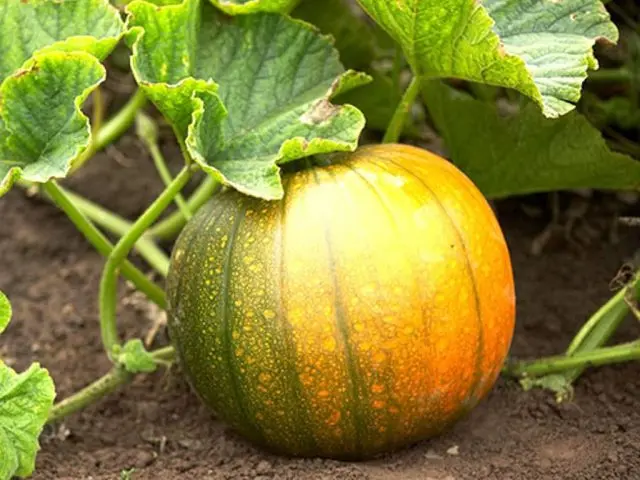
Gold
Acquaintance with the spray pumpkin Golden must begin with a description and varietal characteristics. The plant is mid-season, ripening occurs on the 110th day after seed germination. Forms a compact, slightly climbing shrub. Fruits are flattened spherical shape, weighing up to 5 kg. Golden skin with snow-white streaks, medium density. The bright lemon flesh is sweet, crispy and juicy.
Due to frost and drought resistance, it can be grown throughout Our Country. But, according to gardeners, in order to get an early harvest, it is better to plant the Golden pumpkin in seedlings. The culture bears fruit well on nutritious soil, the planting scheme is 70×70 cm. Subject to agrotechnical rules, fruiting is high from 1 square. m can be removed up to 15 kg.
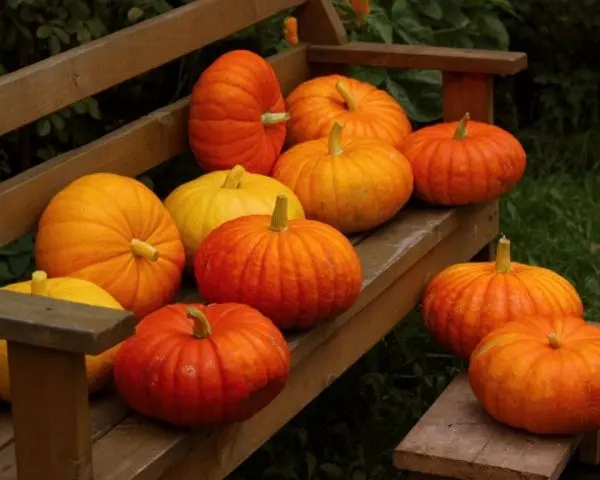
Amazon
Amazon belongs to the bush, compact, mid-season varieties. Harvesting is done 110 days after planting. The flattened vegetables are colored orange with snow-white stripes. Harvest weighing no more than 2 kg has a good presentation and keeping quality. Taste is high. The orange flesh is sweet, crunchy and very flavorful.
The Amazon bush gourd is not a cold-resistant species, so it is recommended to grow it only in regions with a warm climate. Landing pattern – 150×150 cm.
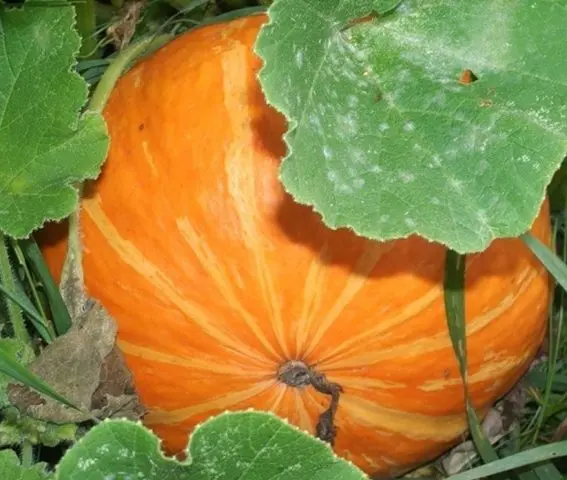
sweet early
Bush pumpkin Early sweet or sweet pie refers to early ripe, table varieties. To grow fruits weighing up to 3 kg, it will take no more than 3 months. The flesh of the orange-red vegetable is soft, crispy, the peel is thin but dense. The plant is universal, suitable for the preparation of preserves, juices, soups. To get a high and stable yield, the bush must be given proper care, which consists in watering, fertilizing and loosening the soil.
The Stoepund
Pumpkin Hundred-pound refers to large-fruited, medium-late varieties. Ripening occurs 140 days after seed germination. The variety forms fruits weighing 10-20 kg.
Fruits with a thin, orange peel may be spherical or oval in shape. The pulp is friable, low-sugar, not fragrant. Due to the lack of a bright taste and aroma, pumpkin is used in the agricultural industry, the ripened crop is often fed to livestock.
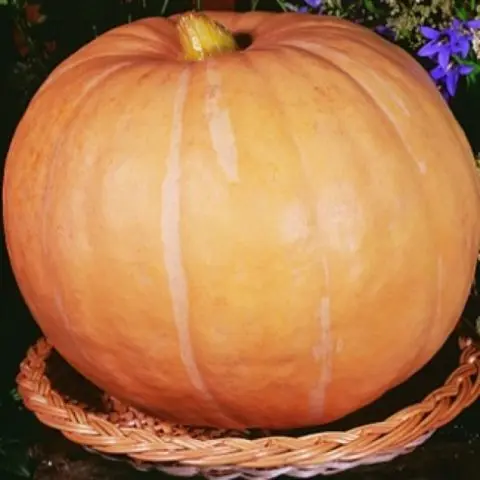
Rouge Vif Detamp
Rouge Vif Detamp was bred by French breeders and is included in the top 10 varieties of bush pumpkin among gardeners. The plant fell in love with its compact size, good taste, high yield. Subject to the agrotechnical rules, pumpkins grow up to 10 kg or more. The application is universal, the crop is suitable for making soups, sauces, juices and preservation for the winter. In regions with a harsh climate, the variety is not recommended to grow, as it will not have time to fully ripen. Due to the low-saccharide pulp, the fruits are recommended for children, diabetics and people who are on a diet.
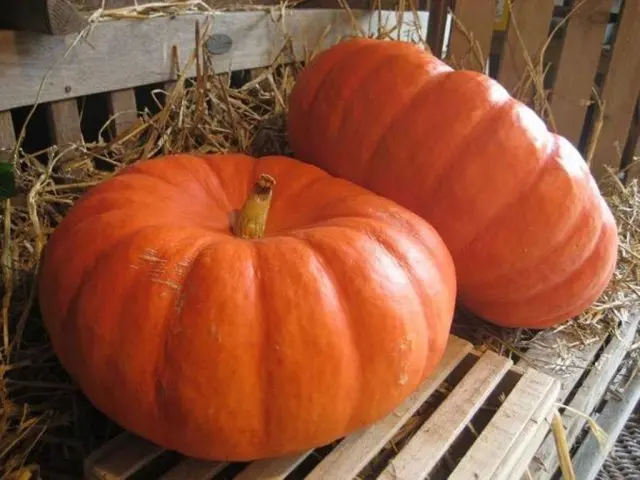
Smile
Smile is a large-fruited pumpkin, with an early ripening period. The plant is cold-resistant and bears fruit well with sharp changes in temperature and humidity. Thanks to these indicators, Smile pumpkin can be grown in Siberia and the Urals. Bright orange fruits are loved for their very sweet and fragrant pulp.
The plant forms a compact, low bush with large light emerald leaves. Due to the dense foliage, the soil does not dry out, retains moisture for a long time.
Hybrid Smile prefers to grow in a well-lit place, at a distance of 80 cm from each other. In order for the fruits to be juicy and sweet, watering is carried out as the soil dries out, and the plant is fed every 15 days with organic and mineral fertilizers.
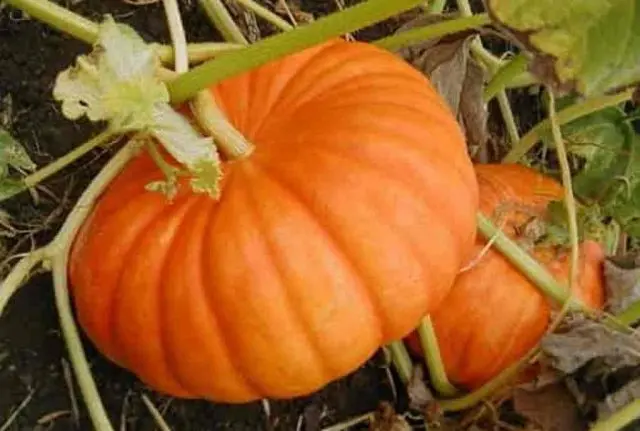
Therapeutic
Medicinal is an early ripe, table variety. The plant forms a small, compact bush. The thin peel of the flattened fruits is dark ash-colored with an unusual dark gray mesh pattern. The bright orange flesh is juicy, crispy and aromatic. The variety retains its taste, presentation and freshness for up to 1 year.
The medicinal bush pumpkin has a drawback – a weak immunity to fungal diseases. In case of non-compliance with agrotechnical rules, the following are added to the plant:
- powdery mildew;
- anthracnose;
- white and gray rot.
Pearl
The pearl belongs to the Muscat varieties of pumpkin. It is recommended to grow in central Our Country. The plant forms about 6 shoots, each forming 1 ovary. The plant is early ripe, harvesting occurs 100 days after planting the seeds.
Ripe fruits, weighing up to 7 kg, have a cylindrical shape of bright orange color. Pumpkin has a high keeping quality, but due to the thin skin it can get mechanical damage during long-term transportation. Due to its high yield, Zhemchuzhina is grown not only on a personal plot, but also on an industrial scale.
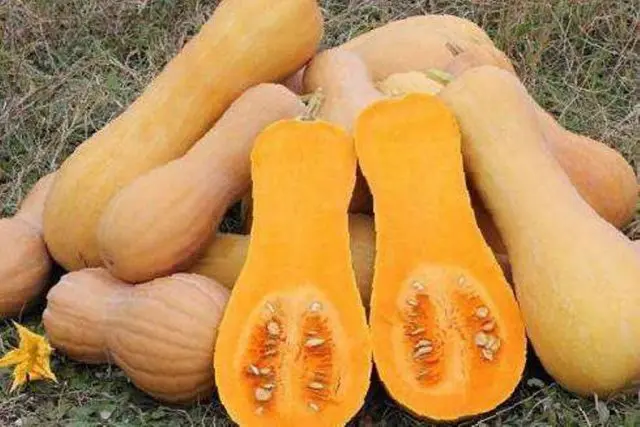
Gribovskaya
Pumpkin Gribovskaya is an old, popular hybrid bred by Soviet breeders. It is widely known among Siberian and Ural gardeners, as it withstands sharp changes in temperature and humidity and brings a stable, plentiful harvest, despite the weather. To obtain an early harvest, the variety is recommended to be grown in seedlings.
The bush form forms elongated fruits, weighing up to 5 kg. The dense, orange peel with dark green stripes protects the juicy and sweet pulp during long-term transportation. Due to the high sugar content, the crop is used to make jams, juices and a variety of desserts.
Fruiting is early, the first pumpkins appear on the 80th day after the appearance of sprouts. If the crop does not have time to ripen in the garden, then the unripe crop ripens safely during storage.
Bush gourd Gribovskaya has strong immunity to powdery mildew and bacteriosis.

Root
Bush pumpkin Prikornevaya was bred by Krasnodar scientists and in 1980 received permission for cultivation in the North Caucasus and Far East regions.
The plant forms a small bush, the fruits are formed near the root collar. The bush is covered with large, heart-shaped leaves, thanks to which the soil remains moist for a long time.
Bush pumpkin Basal refers to early ripe varieties. No more than 110 days pass from sowing seeds to harvesting. Fruits weighing 5-10 kg are painted in a light gray color. Bright orange flesh is firm and juicy.
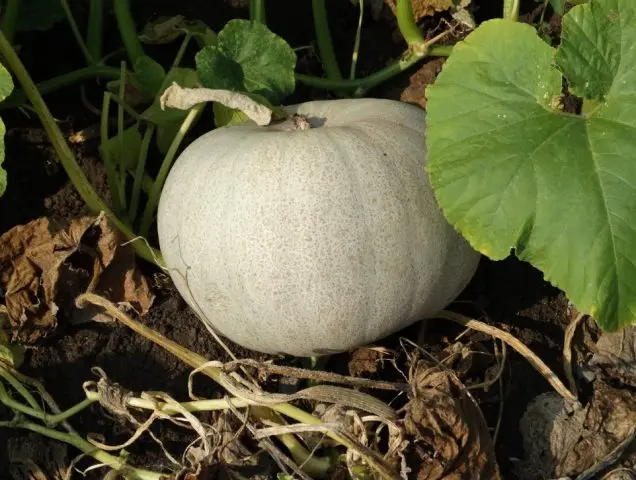
Lel
Variety Lel – early pumpkin culture. In regions with a warm, favorable climate, the first fruits appear already in the middle of summer. They have a medium flattened, ribbed surface, painted in a light ash color with pronounced brown stripes. The pulp is juicy, dense. But, despite the juiciness, the fruits are not used in cooking, but are used for the green conveyor.
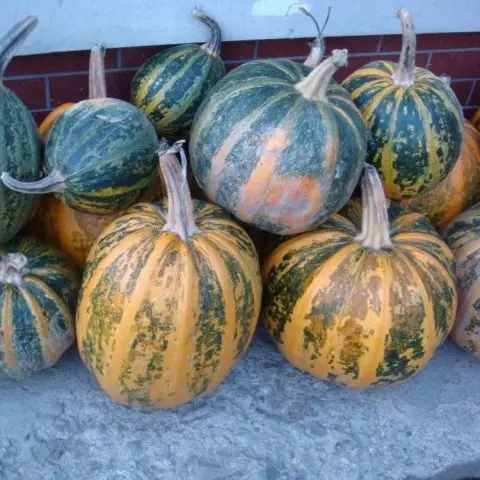
Lel has strong immunity to powdery mildew, anthracnose and peronosporosis. The variety is famous for its creamy seeds, which contain up to 50% fat. Medicines, oil, infusions and tinctures are prepared from them.
Barnaulskaya
Barnaul – refers to mid-season bush pumpkin varieties. The plant forms a small leafy bush and cylindrical fruits, weighing up to 5 kg, of an ashy color. The plant is resistant to fungal diseases, to sudden changes in temperature, bears fruit well in regions with cold, short summers. Due to varietal characteristics, the plant is suitable for growing in Siberia and the Urals.
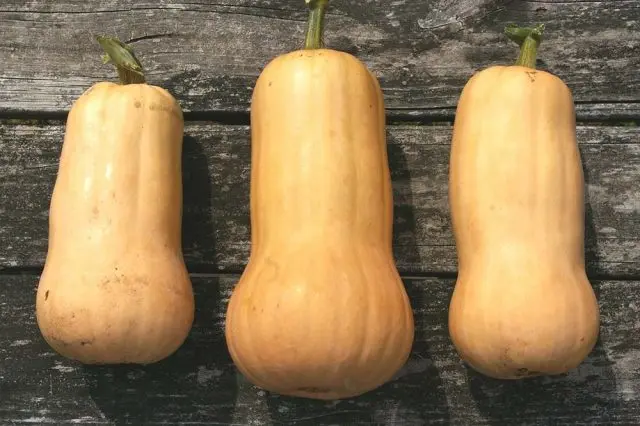
The fruit pulp is dense, juicy, medium sugary. Harvest is suitable for freezing, preparing preparations, vegetable stews and dietary dishes.
Roll
Pumpkin Valok refers to large-fruited, table, bush varieties. Gray fruits, weighing up to 10 kg, are formed at the root collar. The variety is mid-season, oilseed and fodder direction. Ripening occurs 110 days after germination.
The shape of the fetus, weighing up to 8 kg, is spherical. The gray peel is smooth, slightly segmented. The taste is mediocre, but the juice made from the crop is very healthy. The vegetable contains:
- dry matter – 7%;
- sugar – 4,1%;
- carotene – 2,1 mg.
Bush gourd Valok is not subject to long-term storage and transportation, so it is not recommended to grow it on an industrial scale.
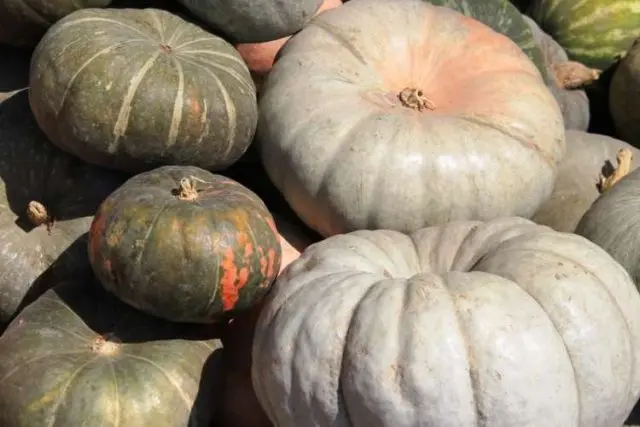
Crocus
A large-fruited variety bred by Soviet scientists. Introduced into the State Register in 1998, allowed for cultivation in the North Caucasus and Nizhnevolzhsky regions. The variety is valued for its good transportability and ability to tolerate temperature drops down to -1-2 °C.
The plant produces fruits weighing up to 5 kg. The pulp is juicy, sweet and aromatic. Crocus is resistant to leaf bacteriosis, but is often subjected to powdery mildew infection. Therefore, when growing this variety, it is necessary to observe agrotechnical rules and carry out preventive measures.
The variety is universal. It is used for making juice, sauces, preparations and preserves.
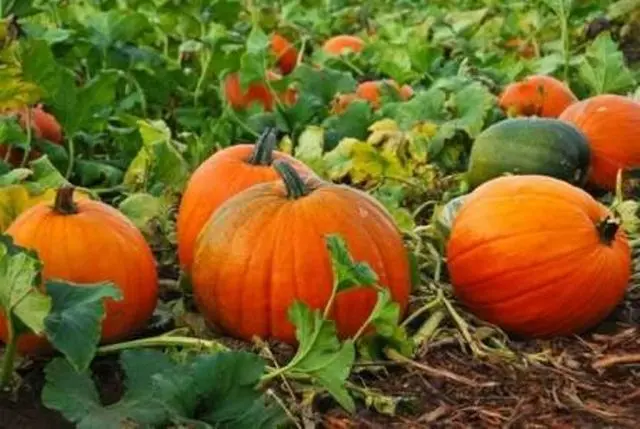
honey beauty
A popular variety of bush pumpkin, imported from China. It is early ripe, ripening occurs 3 months after planting the seeds. Varietal characteristics of the fruit:
- spherical shape;
- orange color of the peel with pronounced green spots;
- weight up to 6 kg;
- thin but dense peel;
- the seeds have a high fat content;
- crispy, juicy, aromatic pulp;
- versatility in application.
Honey beauty is subject to long-term storage, and it is able to endure long-term transportation.
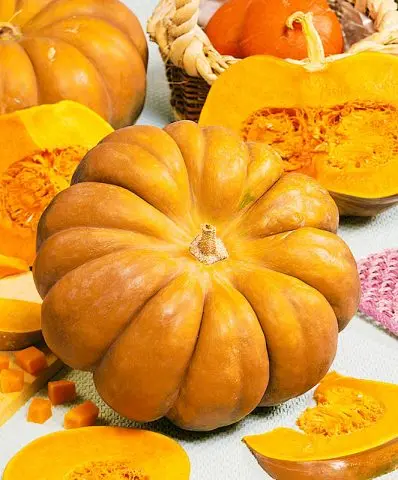
Freckle
Early ripe variety of bush pumpkin. Due to cold resistance, the plant is suitable for growing in Siberia and the Urals. Green fruits with colorful spots ripen 100 days after planting. The flesh of the pumpkin is juicy, soft, with a delicate pear aroma.
Freckle is high-yielding, so it is recommended for commercial cultivation. To obtain a long-awaited harvest, timely care is necessary, which consists in watering, fertilizing and loosening the soil.
Thanks to the juicy, fragrant and beautiful pulp, the fruits look original in winter preparations, vegetable salads and as a side dish for meat and fish.
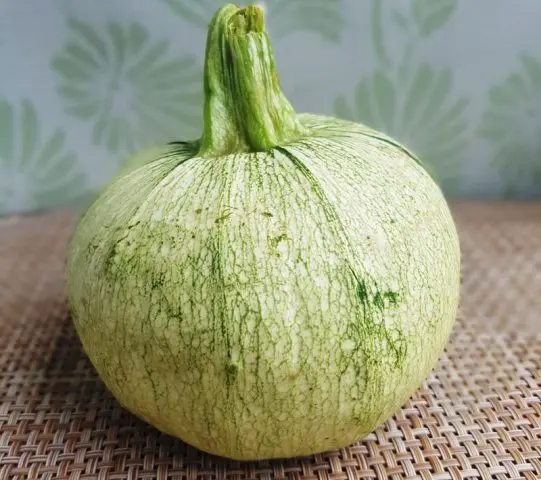
How to choose the right variety of bush pumpkin
In order to wait for the long-awaited result when growing bush pumpkin, you need to choose the right variety. When choosing, consider the following factors:
- frost and drought resistance;
- color and shape of the fruit;
- taste qualities;
- application area;
- storage duration.
Features of growing bush pumpkin
In order for the pumpkin to give a good harvest, it is necessary to follow simple agrotechnical rules.
- Landing – bush gourd prefers to grow in a sunny area with fertile soil.
- Planting material before planting must undergo pre-sowing preparation.
- Abundant irrigation is carried out during flowering and fruiting. Water should be separated and at room temperature. Stop watering 30 days before harvest.
- The soil before planting seeds should be well fertilized.
- If the summer is rainy, then artificial pollination is carried out.
Conclusion
Bush pumpkin is bred for cultivation on a personal plot and on an industrial scale. All varieties are unpretentious and high-yielding. Due to the wide variety, you can choose the most suitable variety that suits the local climate, and then the plant will delight you with a generous harvest of juicy and fragrant fruits.










